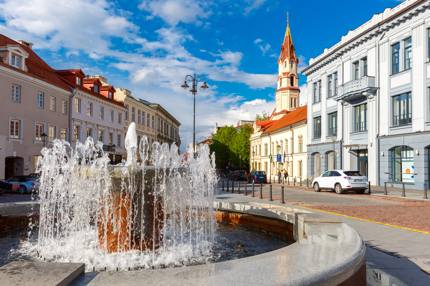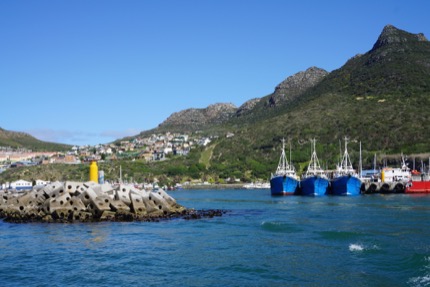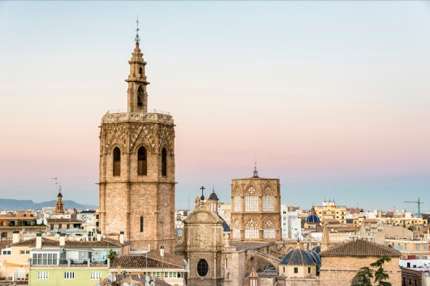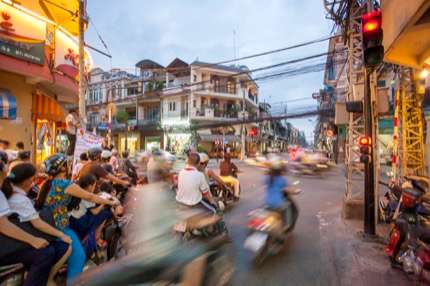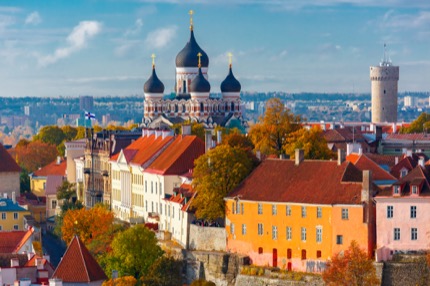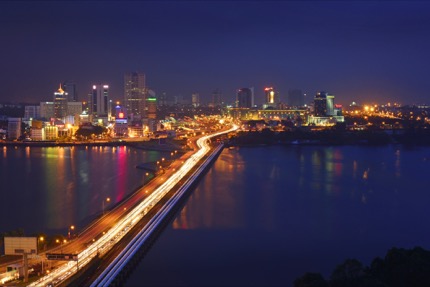Want to be a freelancer? Check out the 10 best cities for freelancers and digital nomads
News travels fast through the grapevine. Someone you know is now sitting on a beach in Thailand, earning a living working online. An idyllic image of a long stretch of sandy beach fringed by palm trees enters your mind. How can someone be so lucky? Don’t envy them; join them! The world is now a well-connected place, meaning you can work from anywhere and at any time. If you want to quit your nine-to-five job in a characterless office cubicle and become a cyber nomad, working from one foreign city to another, then read on to discover the top 10 cities for cyber nomads, and go for it.
10. Vilnius, Lithuania
Not as exotic as Thailand, but Lithuania repeatedly ranks number one for having the fastest public Wi-Fi in the world (taking both download and upload speeds into consideration). This factor alone is enough to bring a smile to any cyber nomad’s face. The capital of Lithuania, Vilnius, has Europe’s largest baroque Old Town which is UNESCO-listed, and also plays host to a lively student population, a zinging nightlife and an ever-evolving spread of bars, cafés and restaurants. Accommodation wise, you can rent a place for about 400 Euros (US$425) per month.
For information on Vilnius, such as getting around, things to see, nightlife and restaurants, check out the Vilnius Travel Guide.
9. Qingdao, China
The birthplace of the famous Tsingtao beer (both Qingdao and Tsingtao have the same pronunciation though the latter is Germanised) is a beautiful seaside city which still preserves its concession-era architecture and the unique Japanese and German influence. Situated between the Yellow Sea and Jiaozhou Bay, Qingdao enjoys its own micro-climate with warmer winters and cooler summers. You can sit on its golden sandy beach and enjoy free Wi-Fi, though you may prefer to use the inexpensive 4G mobile service offered by any of the providers. Fresh seafood dominates the menu, and you can rent an apartment near the seaside for around 3,000 Chinese Yuan (US$435) a month. Before jetting off to Qingdao, it’s important to check out the China Visa & Passport Requirements.
8. Cape Town, South Africa
Africa’s main tech hub, lively Cape Town is ideal for techies who enjoy watching sun rises from the summit of Table Mountain and drinking Cape Chardonnay at lunch in a waterfront bistro. If the beautiful scenery doesn’t keep you occupied, several Information and Communications Technology (ICT) initiatives around town will – after all, it isn’t nicknamed ‘Silicon Cape’ without reason. When it comes to the cost of living, expect to pay around 16 South African Rand (US$1.23) for a bottle of local beer in the supermarket, while a decent room can cost around 10,000 South African Rand (US$766) a month. Check out the Cape Town Travel Guide before you go.
7. Valencia, Spain
Founded in antiquity, Valencia was once ruled by the Romans and the Moors, before becoming a key Mediterranean port town in the 15th century. The Old Town is gorgeous, the beaches are pleasant, and the craft beer scene is burgeoning. Many cafés and restaurants offer free Wi-Fi. You can work in between mouthful of delicious paella, which originated near the Albufera lagoon just south of Valencia. The Metro system is excellent – this means you can rent cheaply in a far-flung suburb but still get downtown in less than 30 minutes. Alternatively, you can also pay around 1,200 Euros (US$1,300) a month for a sea-view apartment and jog along its sandy beach every morning.
Visit the Valencia Travel Guide for useful information.
6. Ho Chi Minh City, Vietnam
Good news first: the government is gradually rolling out free Wi-Fi across Ho Chi Minh City. Now the bad news: the connection speed isn’t fast. But the city still attracts digital nomads in hordes because the place is like a spacecraft; its engineers may still be working on its matter-antimatter reactors but you know that it will roar off into the future in warp speed soon. It’s an exciting time in HCM – you can feel the pulse of the city and its quickening heartbeat – and you just won’t want to leave. In the city, you can rent a flat for around 10 million Vietnamese dong (US$440) a month, while a bowl of hot, steaming and delicious Pho from the market costs as little as 20,000 dong (US$0.88).
You’ll be surprised to learn that Ho Chi Minh City is ideal for you to get your entry-level diving course under your belt. Click on our Ho Chi Minh City Travel Guide for more information.
5. Santiago, Chile
Chile has one of the highest broadband penetration rates in South America. Its dynamic capital, Santiago, has buzzing boulevards and very edgy neighbourhoods fit for creative nomads who appreciate choices in life. There is so much to do in Santiago; you can raft down the Andes’ meltwater, hike in the Patagonian wilderness, or surf the swells west of the city. When it comes to work, free Wi-Fi is readily available in most cafés, just ask for “clave” (which literally means “key”) and they will write it on a piece of paper for you. You can even get free Wi-Fi in many of the metro stations. Rental wise, you can find accommodation for about 320,000 Chilean peso (US$500) a month in a relatively good neighbourhood. Don’t forget to check out the Santiago Travel Guide before you go.
4. Ko Samui, Thailand
There is a chain of three beautiful islands in the Gulf of Thailand: Ko Samui, Ko Pha Ngan, and Ko Tao. Ko Samui is the biggest island and most suitable for digital nomads thanks to its accessibility (flying in and out is easy), high number of free Wi-Fi zones, lovely beaches, and a very relaxing atmosphere. For some exhilarating fun, take a short boat ride to Ko Pha Ngan and join 30,000 tourists for the monthly Full Moon Party. You can live inexpensively in Ko Samui, paying as little as 9,000 Thai Baht (US$258) a month for a place, or you can splash out and rent a villa complete with a pool for 35,000 Thai Baht (US$1,000) a month. Refer to our essential Thailand Travel Guide especially if you want to use Ko Samui as a base to explore Thailand.
3. Tallinn, Estonia
Tallinn is fast becoming one of Europe’s startup capitals. In fact, Estonia was the first country to declare that Internet access is a human right. This belief drives a thriving IT culture; couple that with the low cost of living and widespread use of English, and you can see why digital nomads congregate at the many cafés and shared workspaces in Tallinn, the capital city. Expect to sit on golden sandy beaches in the summer and join the beach party when the sun goes down – check out the Tallinn Travel Guide for things to do and see. Accommodation wise, you can rent a nice place for about 500 Euros (US$530) per month.
2. Chiang Mai, Thailand
Chiang Mai has been crowned the best place by digital nomads multiple times. The city draws you in with its balmy weather, great food, and excellent networking programmes dedicated to digital nomads. If spending too much time in front of the laptop is stressing you out, head to town for a Thai massage or participate in the city’s Monk Chat programme, where you sit at a round table and talk to young monks and their teachers. Chiang Mai’s nightlife is buzzing with excitement and focused in three main areas – all the information is included in our Chiang Mai Travel Guide. When it comes to cost of living, Chiang Mai is cheaper than Bangkok and other southern cities. A stylish and fully furnished one-bedroom apartment costs around 11,700 Thai Baht (US$375) a month.
1. Johor Bahru, Malaysia and Singapore
Being resourceful is a trait shared by many successful digital nomads. So how do you take advantage of Singapore’s ubiquitous high-speed broadband and mobile network without forking out at least 4,000 Singapore Dollars (US$2,800) in living expenses a month? By living in Johor Bahru, Malaysia, and taking the bus to Singapore. The distance between these two countries is just 10km (6 miles), but the contrast can’t be more startling. While Singapore is expensive, Johor Bahru is cheap – you can rent an apartment for about 1,500 Ringgit (USD$336) a month. To get to Singapore, just hop on buses 170, CW1, CW2. They all take you straight into Singapore; though we recommend that once you reach Singapore, you get off at Kranji Metro Station and change to the highly efficient Metro, or MRT as it is locally known. Alternatively, you can get bus CW3 which uses the second causeway. Just one word of advice: avoid peak hours. This winning combination also allows you to use both countries as a base to explore Southeast Asia, Australia and New Zealand.
Fancy using these countries as a base? Check out our Malaysia Travel Guide and Singapore Travel Guide for more information.
This article was updated on 1st of May 2018

